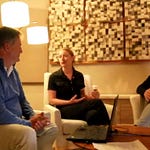AgBio, sustainability and DoE all come together in this episode. Tim Cuthbertson is the Chief Science Officer at VelociGro where they are using Design of Experiments to optimize plant growth media for vertical farming.
I was curious to learn about the concept of vertical farming and how it can make an impact relative to the massive acreage involved in traditional agriculture. There are scenarios where it makes a lot of sense. First of all, greenhouse-grown produce is nothing new. Tomatoes are the most commonly grown crop in what is known as protected agriculture. And overall, in 2019, 55% of vegetable growers had some component of indoor operation, extension of the growing season being the primary reason. A greenhouse can produce 2.5 pounds of food per square foot per year. That’s horizontal growth.
Growing plants vertically should increase that productivity further. So where is the impact? Consider what it takes to send blueberries from Chile to Alaska. Now what if blueberries could be grown indoors locally year-round? With LED lighting (which apparently doesn’t have to work on a 100% duty cycle) there could be significant savings in carbon emissions. Not to mention loss from spoilage etc in transit.
In case you haven’t heard, the Panama Canal is backed up and the largest container ships can’t go through with a full load currently because there is not enough water in Lake Gatun due to decreased rainfall. That means produce either being offloaded elsewhere and sent by train or truck or a longer trip around Cape Horn and associated delays. Don’t miss my upcoming episode on “the ethylene problem”. We’ll talk about what it takes to keep fruit “fresh” on those long journeys.
Sorry to interrupt. Not subscribed yet? Let’s fix that.
Either way, I appreciate you spending time here.
Local access to fresh produce in urban areas is another opportunity to deploy vertical farming. It occurs to me that a lot of empty office space is ripe (yeah, I said it) for conversion to urban indoor agriculture. I’m beginning to imagine a back-to-the-office campaign where a company leases some of its space for growing produce to be sold while allowing people who come back to the office to have access to a share of the crop to take home each week.
Where does Design of Experiments come in? We covered DoE in a previous episode. Briefly, it’s a method of testing multiple variables simultaneously to quickly iterate and find the optimal solution to a problem or process. A typical one-factor-at-a-time (OFAT) approach makes all the results dependent on the optimal value of the first variable you test. That doesn’t in any way guarantee the best final outcome.
How is VelociGro using DoE? We didn’t go into details about their products. Whether plants are grown on a substrate or in a soil-free environment, they need nutrients to grow. DoE allows their company of six people to iterate and optimize formulas for new products in as little as six weeks. Even if agriculture is not your field, you can see how DoE can save huge amounts of time in product or method development.
It strikes me that once again, regardless of what area of the life sciences you work in, thinking about how things are done is as important for delivering a successful product as the science that goes into the product itself.
Your deepest insights are your best branding. I’d love to help you share them. Chat with me about custom content for your life science brand. Or visit my website.















Share this post